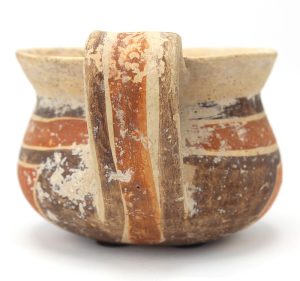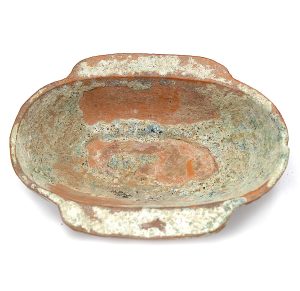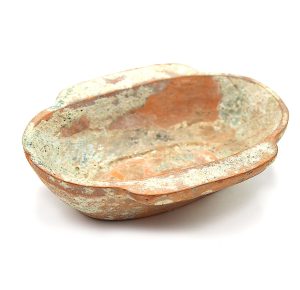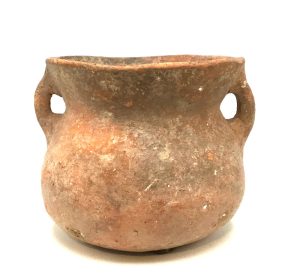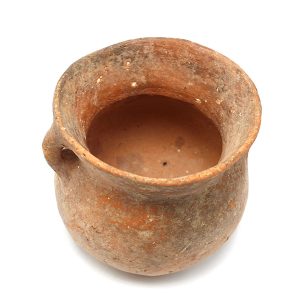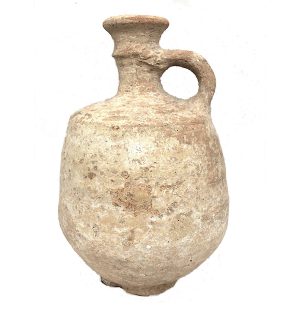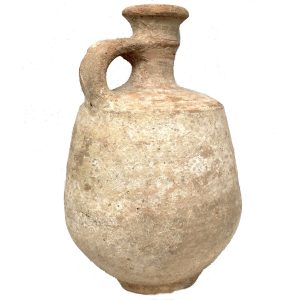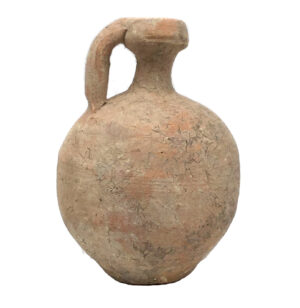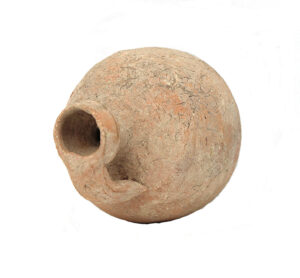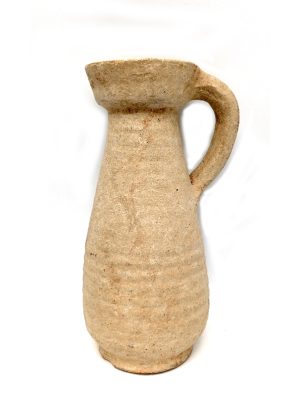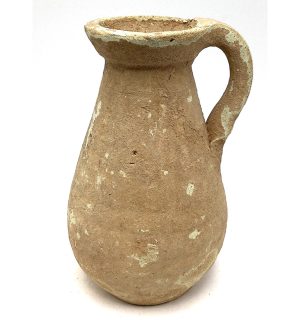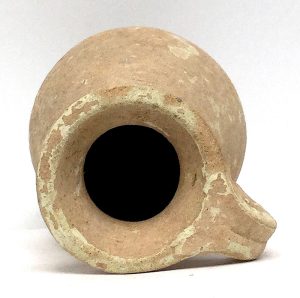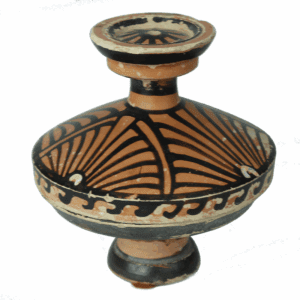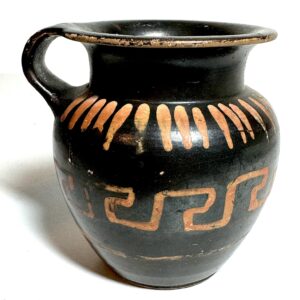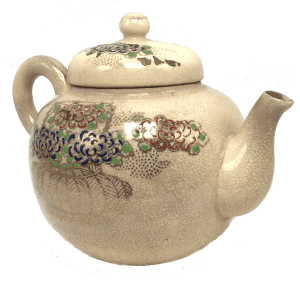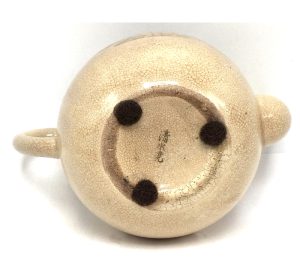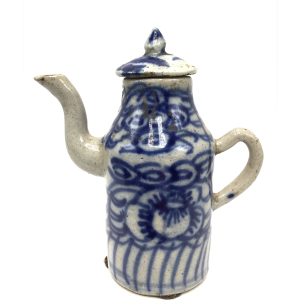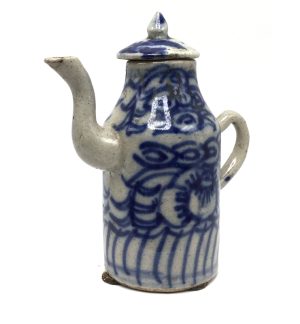Showing 1–12 of 64 results
-
Sale!


$695.00 Original price was: $695.00.$550.00Current price is: $550.00.
H: 3” W: 4.75” D: 4” | FREE SHIPPING IN CONTINENTAL U.S.
This Daunian style earthenware cup was produced in the ancient northern Italian region Apulia, then known as Magna Graecia, from the 6th or 5th centuries B.C.E.. It was covered with beige slip and painted with red, brown and black earth colors in a variety of geometric patterns. Its curved rim and high handle was ideal for pouring liquids like water and wine. The handle may have been repaired as there is an uneven slip underneath it or may have been attached it was painted but it is otherwise in very good condition.
-
Sale!


$450.00 Original price was: $450.00.$310.00Current price is: $310.00.
H: 1.5″ W: 5.125 ” D: 3.875 ” | FREE SHIPPING WITHIN CONTINENTAL U.S.!
Used for rituals and ceremonies, lead green glazed earthenware wing cups were popular burial objects. The tomb’s humidity caused the lead to oxidize to a lustrous, prized iridescent, silver-green.
-
Sale!


$395.00 Original price was: $395.00.$315.00Current price is: $315.00.
H: 2.5″ W: 4.5″ D: 2.375″ | FREE SHIPPING WITHIN CONTINENTAL U.S.!
This diminutive mingqi pig is totally charming and fanciful with an iridescent glaze and would be especially appealing as a send off for the deceased to the nether world or in a contemporary setting. Pigs were especially prized and images were often included as items the deceased would need to live comfortably in the after life.
-
Sale!


$395.00 Original price was: $395.00.$275.00Current price is: $275.00.
H: 3.375” W: 4.25” D: 3.75” | FREE SHIPPING WITHIN CONTINENTAL U.S.
This ancient Judean vessel created during Israel’s Biblical Period was hand shaped using the coil method. It likely held potable liquids, cooking oil or other items. This is a rather sophisticated piece for Bronze Age vessel made millennia ago.
-
Sale!


$750.00 Original price was: $750.00.$595.00Current price is: $595.00.
H: 8.5” Dia: 5.5” | FREE SHIPPING within Continental U.S.!
Wine jugs from in the Judean Holy Land at the time of the first Jewish Temple were used for religious ceremonies and wine blessing as an important Jewish prayer. This carinated piece was made using the coil construction method and the paddle and anvil technique.
-
Sale!


$395.00 Original price was: $395.00.$295.00Current price is: $295.00.
H: 4” Dia: 2.75″ | FREE SHIPPING WITHIN CONTINENTAL U.S.!
This Judean perfume juglet from the Holy Land’s Biblical Period was used throughout the Roman Empire to hold perfume or other costly items. Uncleaned, good condition, no repairs, aged patina, surface incrustation and mineral deposits, hairline cracks, and minor discoloration.
-
Sale!


$295.00 Original price was: $295.00.$195.00Current price is: $195.00.
Ht: 6.25” W: 3.25” D: 2.75” | FREE SHIPPING WITHIN CONTINENTAL U.S. !
Made in Roman North Africa, this small pouring vessel made of durable materials was called coarse wear for everyday use. Elegant in its simplicity It was made with a potters wheel. A fine small piece of history.
-
Sale!


$275.00 Original price was: $275.00.$210.00Current price is: $210.00.
H: 4.5” W: 3” D: 2.75” | FREE SHIPPING WITHIN CONTINENTAL U.S. !
Greek style Oenochoe wine jugs were made in Roman North Africa and exported throughout the empire. Potters wheel made unadorned coarse wears like this small vessel with everted rim were made for daily use and for offerings to deities.
-
Sale!


$595.00 Original price was: $595.00.$450.00Current price is: $450.00.
Ht: 3.5” Dia: 3.5” FREE SHIPPING WITHIN CONTINENTAL U.S.
ancient xenon ware lekanis from Apulia in Magna Graecia, Roman name for the South Italy coastal area. With close-fitting top held cosmetics. Considered fine ware, fathers filled them with jewelry for their daughters’ wedding gifts.
-
Sale!


$595.00 Original price was: $595.00.$475.00Current price is: $475.00.
H: 3.125” W: 3” D: 2.875” | FREE SHIPPING IN CONTINENTAL U.S.
Miniature 4th century BCE elegant xenon Apulia vessel, flared rim and handle, with painted orange geometric designs which may have been a child’s cup or used for votive purposes.
-
Sale!


$285.00 Original price was: $285.00.$225.00Current price is: $225.00.
H: 4” W: 5.25” D: 3.5” | FREE SHIPPING WITHIN CONTINENTAL U.S.
Hand thrown and -painted Meiji single serving Kyo Ware teapot with luminescent crackled glaze and kiln seal. A chrysanthemum in a basket symbolizes longevity and rejuvenation. Kyo ware is limited, making it collected worldwide.
-
Sale!


$135.00 Original price was: $135.00.$95.00Current price is: $95.00.
H: 5.25″ W: 4.625″ D: 2.375″ | FREE SHIPPING WITHIN CONTINENTAL U.S.
Charming miniature pitcher probably used in a restaurant or home kitchen as a dispenser for soy sauce, oils or other liquids. Elegant shape, covered with chrysanthemums, plantain leaves and bindweed vines with lotus bud on top.
End of content
End of content


